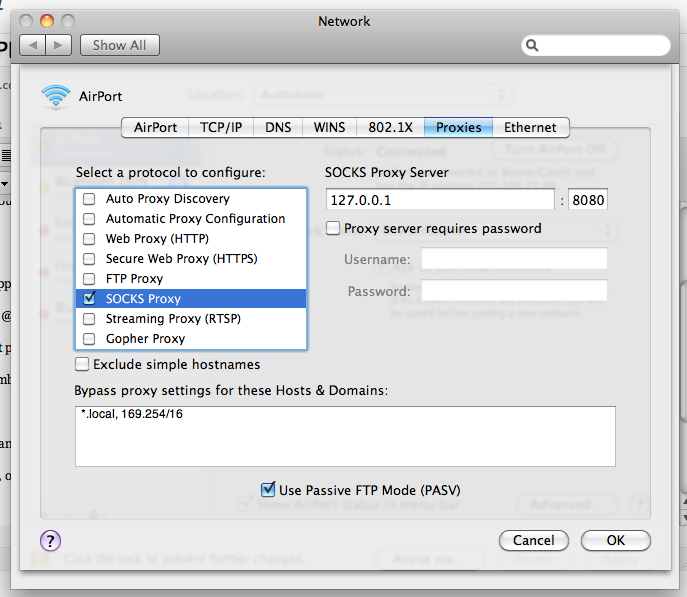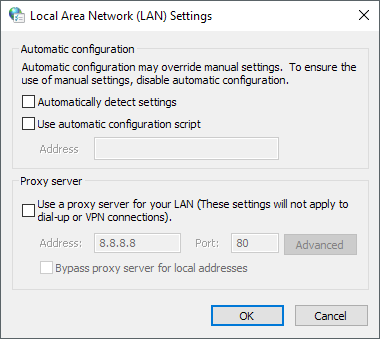- Proxy Server For Macbook
- Proxy Server For Mac
- Best Proxy Servers For Mac
- Mac Proxy Server Software
- Free Proxy Servers For Mac
If you are getting “Unable to Connect to Proxy Server” message on your computer, you will find below the steps to fix this error in Windows 10.
Disable Proxy Settings. If you are not using Proxy Server or VPN, you should be able to fix the error. Here's how to set up your Windows PC, Mac, or browser so you can use a proxy server to your advantage. A proxy server is a gateway between you and the internet. When you visit a website, the proxy server communicates with it on behalf of your browser. Then, when the website answers, the proxy forwards the data to you. Aug 06, 2020 An anonymous proxy server also called a CGI proxy, is a server that works through a web form so that all the internet requests are first filtered through the form, essentially masking your identity. Setting up a device to use an anonymous proxy isn't difficult at all. When you configure a proxy server on your Mac, applications will send their network traffic through the proxy server before going to their destination. This may be required by your employer to bypass a firewall, or you may want to use a proxy to bypass geoblocking and access websites that aren’t available in your country. Firefox on Mac uses the Mac system settings to configure the proxy server. This is how you open it. Click on the Firefox menu and then select Preferences. Now scroll down till you see the Network.
Unable to Connect to Proxy Server in Windows 10
If you are seeing “Unable to Connect to Proxy Server” Error in Windows 10, the reason is usually due to misconfiguration in proxy settings on your computer.
If you are using a Proxy server or VPN, this error can be fixed by making corrections as required for the VPN settings on your computer.
Proxy Server For Macbook
If you are not using a Proxy Server (VPN), you can fix this error by disabling the option to use Proxy Settings on your PC and scanning your computer for malware.
Proxy Server For Mac
Apart from faulty Proxy settings, this error can also be caused by network and browser related problems.
1. Disable Proxy Settings
If you are not using Proxy Server or VPN, you should be able to fix the error by disabling proxy settings on your computer.
1. Open Settings and click on Network and Internet tab.
2. On the next screen, scroll down and click on Proxy in the left-pane. In the right-pane, scroll down and uncheck Use a Proxy server option.

Make sure that ‘Address’ and ‘Port’ Fields under ‘Manual Proxy Setup’ section are empty.
After disabling Proxy server, open the web browser on your computer and see if you are able to connect to internet.
2. Reset Internet Options
Unable to connect to Proxy Server error in Windows 10 can also be caused by change in internet settings.
1. Right-click on the Start button and click on Run.
2. In Run Command window, type inetcpl.cpl and click on OK.
Best Proxy Servers For Mac
3. On internet properties screen, select Advanced tab and click on the Reset button.
4. On the next screen, check Delete Personal Settings option and click on Reset.
Restart your Computer and see if you are still getting “Unable to Connect To Proxy Server” Error on your computer.
3. Clear Browser Cache
Clear the browser Cache on your computer to rule out the possibility of old cached web pages being served by the web browser.
1. Open Chrome browser > click on 3-dots menu icon > More Tools > Clear Browsing Data.
2. On the next screen, set All Time as the ‘Time Range’ > check Browsing History, Cookies and other site site data, Cached images and files options and click on Clear Data button.
After Clearing Browsing Cache, see if you are able to connect to internet.
4. Flush DNS and Reset IP
1. Right-click on Start button and click on Command Prompt (Admin).
2. On Command Prompt screen, type the following Commands one-by-one and hit the enter key after each command.
- ipconfig /flushdns
- netsh int ip reset
- netsh winsock reset
After executing above Commands, Restart your computer.
5. Reset Chrome Browser
1. Open Chrome browser on your computer.
2. Click on 3-dots menu icon and select Settings option in the drop-down menu.
3. On Settings screen, scroll down to bottom and click on Advanced.
4. On the next screen, scroll down and click on Restore Settings to their original defaults option, located under ‘Reset and clean up’ section.
5. On the confirmation pop-up, click on Reset Settings button to confirm.
6. Scan Computer for Harmful Programs

Google’s Chrome browser comes with an in-built tool that can help you find and remove harmful programs on your computer.
1. Open Chrome > click on 3-dots menu icon > Settings > Advanced.
2. Scroll down and click on Clean up computer option located under “Reset and Clean up” section.
3. Next, click on Find to allow Chrome browser to start searching for harmful programs on your computer.
If Chrome finds harmful or suspicious programs click on Remove and follow the instructions to remove the program.
You can also use the Antivirus program installed on your computer or use Windows Defender offline scan to check your computer for malware and harmful programs.

7. Check Proxy Server Settings
If you are using a Proxy Server or VPN to connect to the internet, check the VPN Settings on your computer and make corrections as required.
1. Open Settings and click on Network and Internet.
2. On the next screen, click on VPN in the left-pane. In the right-pane, click on VPN Name > Advanced Options.
3. On the next screen, make sure your VPN Name, Address and other required details are correct. If not, click on the Edit button.
Mac Proxy Server Software

4. On the next screen, Enter Correct VPN Name and Address.
After correcting Proxy Settings, you should be able connect to internet using VPN settings on your computer.
Free Proxy Servers For Mac
Additionally, are you looking to just proxy the traffic (potentially caching content at your network edge) or are you looking for content filtering, too (e.g. prevent users visiting certain sites)?
If you're just looking for a web proxy then you can just build and install squid (it works well), or use the built-in Apache 2 server (although I would recommend upgrading to apache 2.2 rather than the 2.0.x bundled version).
If you've used squid in the past then that might be the easier way to go. Squid can also act as a proxy for other protocols, so it might fit your needs better.
Both Squid and Apache require configuring via the terminal. If you're not familiar with building applications on the command line then you might consider a commercial package such as InterGate which packs a proxy server into a package along with various other 'net goodies (rate filtering, connection teaming, NAT, content filters, etc.).
Should I reposition the Server between the users router and internet connection
That depends. If you want to force users to go through the proxy you might have to otherwise you're relying on users' systems being configured to use the proxy, which experienced users might be able to circumvent.
I cannot locate the internet sharing tab. I have checked the proxy box but know it isn't that easy.
In Mac OS X Server, all sharing functions are controlled via either Workgroup Manager (sharepoints, access control, etc.) or Server Admin (process configuration/stop/start/monitoring), but there's no 1-button proxy server setting.
